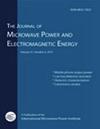Process parameters of microwave heating-assisted vacuum evaporation of tomato juice: quality, energy consumption, exergy performance, and kinetic processing
IF 1.5
4区 工程技术
Q4 ENGINEERING, CHEMICAL
Journal of Microwave Power and Electromagnetic Energy
Pub Date : 2023-07-03
DOI:10.1080/08327823.2023.2235551
引用次数: 0
Abstract
Abstract Increasing heating performance and preservation of product quality are critical factors in the food industry. Although microwave-vacuum heating is applied in many food processes, there are many unanswered questions about its effects on sensitive foods. In this study, the tomato juice was concentrated in microwave-vacuum heating system and results compared with conventional and conventional-vacuum heating methods. The effect of pressure and microwave power was investigated on quality parameters, energy consumption, exergy performance, and processing kinetics of tomato juice concentration. The processing time in the microwave-vacuum method was 2.3 to 6.3-fold lower than conventional and conventional-vacuum methods. The exergy performance was obtained in the range of 7.16–13.29% for microwave-vacuum heating and 2.04–2.99% for conventional methods. Microwave vacuum heating could reduce energy consumption by 30–71%, compared with conventional-vacuum methods. The minimum decline in ascorbic acid and total phenol content of tomato juice concentrate was observed for microwave-vacuum evaporation. Microwave-vacuum heating was an excellent concentration technique that provided tomato paste with improved nutritional quality, increasing exergy efficiency, reducing processing time and energy consumption compared to conventional and conventional vacuum processes.微波辅助真空蒸发番茄汁工艺参数:品质、能耗、火用性能、动力学处理
提高加热性能和保持产品质量是食品工业的关键因素。虽然微波真空加热在许多食品加工过程中得到应用,但它对敏感食品的影响仍有许多未解之谜。本研究将番茄汁浓缩在微波真空加热系统中,并与常规和常规真空加热方法进行了比较。研究了压力和微波功率对番茄汁浓缩的质量参数、能量消耗、火用性能和加工动力学的影响。微波真空法处理时间比常规和常规真空法缩短2.3 ~ 6.3倍。微波真空加热法的火用性能为7.16 ~ 13.29%,常规加热法的火用性能为2.04 ~ 2.99%。与传统真空加热相比,微波真空加热可降低能耗30-71%。微波真空蒸发对浓缩番茄汁中抗坏血酸和总酚含量的影响最小。微波真空加热是一种优良的浓缩技术,可以提高番茄酱的营养品质,提高火用效率,减少加工时间和能耗。
本文章由计算机程序翻译,如有差异,请以英文原文为准。
求助全文
约1分钟内获得全文
求助全文
来源期刊

Journal of Microwave Power and Electromagnetic Energy
ENGINEERING, CHEMICAL-ENGINEERING, ELECTRICAL & ELECTRONIC
CiteScore
2.50
自引率
6.70%
发文量
21
期刊介绍:
The Journal of the Microwave Power Energy (JMPEE) is a quarterly publication of the International Microwave Power Institute (IMPI), aimed to be one of the primary sources of the most reliable information in the arts and sciences of microwave and RF technology. JMPEE provides space to engineers and researchers for presenting papers about non-communication applications of microwave and RF, mostly industrial, scientific, medical and instrumentation. Topics include, but are not limited to: applications in materials science and nanotechnology, characterization of biological tissues, food industry applications, green chemistry, health and therapeutic applications, microwave chemistry, microwave processing of materials, soil remediation, and waste processing.
 求助内容:
求助内容: 应助结果提醒方式:
应助结果提醒方式:


